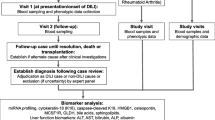Abstract
Temozolomide (TMZ) is used to treat adult patients with glioblastoma multiforme (GBM). Cases of hepatotoxicity have been reported among patients using TMZ. The objective of the study was to assess the relation, if any, between exposure to TMZ and serious acute liver injury (SALI). We used the HealthCore Integrated Research Database to perform a case-control study nested within a retrospective cohort of adult patients aged 18–100 years with at least two diagnoses of brain cancer anytime between 2006 and 2014. Patients without continuous eligibility or with a SALI diagnosis within 6 months prior to the date of incident brain cancer diagnosis were excluded. Medical records were sought for potential SALI cases and reviewed by two hepatologists. Five controls were selected for each case using incidence density sampling, matched on age and calendar year of index date. The analysis included 61 confirmed SALI cases and 305 selected controls. Exposure to TMZ was classified according to dispensing date and days supply of medication dispensed. We estimated odds ratios using conditional logistic regression models. The odds ratio for any exposure to TMZ was 0.91 (95% CI 0.44–1.91), for recent exposure to TMZ was 0.62 (95% CI 0.21–1.85). There was no increased risk of SALI with increasing duration of exposure to TMZ. When patients with unconfirmed SALI were included in the analysis, results were similar (OR 1.04; 95% CI 0.70–1.54). In conclusion, this study did not find an association between TMZ and SALI risk among patients with brain cancer.

Similar content being viewed by others
Explore related subjects
Discover the latest articles and news from researchers in related subjects, suggested using machine learning.References
Omuro A, DeAngelis LM (2013) Glioblastoma and other malignant gliomas: a clinical review. Jama 310(17):1842–1850
Temodar [package insert]. Merck & Co., Inc., Research Laboratories, North Wales, PA; 2017. https://www.merck.com/product/usa/pi_circulars/t/temodar_capsules/temodar_pi.pdf
Stupp R et al (2009) Effects of radiotherapy with concomitant and adjuvant temozolomide versus radiotherapy alone on survival in glioblastoma in a randomised phase III study: 5-year analysis of the EORTC-NCIC trial. Lancet Oncol 10(5):459–466
Malmström A et al (2012) Temozolomide versus standard 6-week radiotherapy versus hypofractionated radiotherapy in patients older than 60 years with glioblastoma: the Nordic randomised, phase 3 trial. Lancet Oncol 13(9):916–926
Sarganas G et al (2012) Severe sustained cholestatic hepatitis following temozolomide in a patient with glioblastoma multiforme: case study and review of data from the FDA adverse event reporting system. Neuro-Oncol 14(5):541–546
Hruban RH, Sternberg SS, Meyers P et al (1999) Fatal thrombocytopenia and liver failure associated with carboplatin therapy. Cancer Invest 9:263
Thatishetty AV, Agresti N, O’Brien CB (2013) Chemotherapy-induced hepatotoxicity. Clin Liver Dis 17(4):671–686
Huerta C, Zhao SZ, L.A.G. Rodríguez (2002) Risk of acute liver injury in patients with diabetes. Pharmacotherapy 22(9):1091–1096
Devarbhavi H, Andrade RJ (2014) Drug-induced liver injury due to antimicrobials, central nervous system agents, and nonsteroidal anti-inflammatory drugs. In: Seminars in liver disease. Thieme Medical Publishers, Stuttgart
Nazario HE, Lepe R, Trotter JF (2011) Metastatic breast cancer presenting as acute liver failure. Gastroenterol Hepatol 7(1):65–66
Rubbia-Brandt L et al (2004) Severe hepatic sinusoidal obstruction associated with oxaliplatin-based chemotherapy in patients with metastatic colorectal cancer. Ann Oncol 15(3):460–466
Rothman KJ, Greenland S, Lash TL (2008) Case-control studies. In: Rothman KJ, Greenland S, Lash TL (eds) Modern epidemiology, vol 3. Wolters Kluwer Health/Lippincott Williams & Wilkins, Philadelphia, pp 11–127
Lo Re V et al (2013) Validity of diagnostic codes to identify cases of severe acute liver injury in the US Food and Drug Administration’s Mini-Sentinel Distributed Database. Pharmacoepidemiol Drug Saf 22(8):861–872
Katz AJ et al (2013) Assessment of case definitions for identifying acute liver injury in large observational databases. Drug Saf 36(8):651–661
Fosgate G (2006) Non-differential measurement error does not always bias diagnostic likelihood ratios towards the null. Emerg Themes Epidemiol 3(1):1
Herrlinger U et al (2006) Phase II trial of lomustine plus temozolomide chemotherapy in addition to radiotherapy in newly diagnosed glioblastoma: UKT-03. J Clin Oncol 24(27):4412–4417
Hansen MM, et al (1982) Fatal hepatitis following irradiation and vincristine. Acta Med Scand 212(3):171–174
Floyd J, Mirza I, Sachs B et al (2006) Hepatotoxicity of chemotherapy. Semin Oncol 33(1):50–67
Hofmann MA et al (2007) High-dose platinum combination therapy in pretreated patients with disseminated melanoma. Chemotherapy 53(6):422–428
Acknowledgements
This study was funded by Merck & Co., Inc.
Author information
Authors and Affiliations
Corresponding author
Ethics declarations
Conflict of interest
This study was funded by Merck & Co. Vibha Desai, Stephan Lanes and Crystal Holick are employees of HealthCore. Scott Quinlan was an employee of HealthCore at the time the study was conducted. Anne Deitz and Jinghua He are employees of Merck & Co. The study was presented as a poster at International Conference of Pharmacoepidemiology, 32nd Annual Conference in Dublin, Ireland.
Appendix
Appendix
See Table 3.
Rights and permissions
About this article
Cite this article
Desai, V.C.A., Quinlan, S.C., Deitz, A.C. et al. Risk of severe acute liver injury among patients with brain cancer treated with temozolomide: a nested case-control study using the healthcore integrated research database. J Neurooncol 134, 89–95 (2017). https://doi.org/10.1007/s11060-017-2489-6
Received:
Accepted:
Published:
Issue Date:
DOI: https://doi.org/10.1007/s11060-017-2489-6




